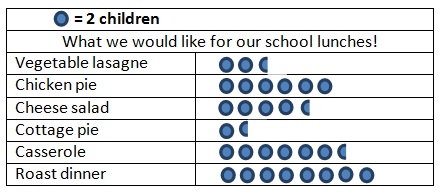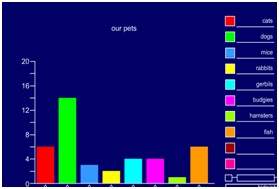“Teachers should use every relevant subject to develop pupils’ mathematical fluency. Confidence in numeracy and other mathematical skills is a precondition of success across the national curriculum.”
– The National Curriculum in England Framework document. September 2013 page 10
Making connections to other topics within this year group
Number and place value
When working on statistics and/or number and place value, there are opportunities to make connections between them, for example:
When learning about number and place value the children are expected to count in and use multiples of 2, 3, 4, 5, 8, 10, 50 and 100. When presenting data, the children are expected to use simple scales for example, 2, 5, 10 units per centimetre, in pictograms and bar charts. The connections between the two are obvious! Give the children opportunities to practise using the required multiples when creating bar charts and pictograms. You could ask the class to pick their favourite food, pet or sport from a given list and then to make a bar chart or pictogram choosing the scale that they think is most appropriate.
Addition and subtraction
When working on statistics and/or addition and subtraction, there are opportunities to make connections between them, for example:
The requirements for statistics include solving one and two step problems, answering ‘How many more?’ and ‘How many fewer?’ questions using information that is presented in bar charts, pictograms and tables. Clearly, solving such problems requires the ability to add and subtract. When covering these concepts you could provide the children with copies of bar charts, pictograms and tables and ask them to then make up and solve problems involving addition and subtraction.
Properties of shape
When working on statistics and/or geometry: properties of shape, there are opportunities to make connections between them, for example:
During the children’s work on properties of shape, give them opportunities to sort a variety of 2D and/or 3D shapes into Venn and Carroll diagrams according to criteria that they choose for themselves.
Making connections to this topic in adjacent year groups
Year 2
Statutory requirements
- interpret and construct simple pictograms, tally charts, block diagrams and simple tables
- ask and answer simple questions by counting the number of objects in each category and sorting the categories by quantity
- ask and answer questions about totalling and comparing categorical data
Non Statutory guidance
Pupils record, interpret, collate, organise and compare information (e.g. using many-to-one correspondence with simple ratios 2, 5, 10).
Year 4
Statutory requirements
- interpret and present discrete and continuous data using appropriate graphical methods, including bar charts and time graphs
- solve comparison, sum and difference problems using information presented in bar charts, pictograms, tables and other graphs
Non Statutory guidance
Pupils understand and use a greater range of scales in their representations.
Pupils begin to relate the graphical representation of data to recording change over time.
Cross-curricular and real life connections
Learners will encounter statistics in:
Within the science curriculum there are opportunities to work with statistics, for example, in working scientifically there is a requirement that the children record findings using simple scientific language, drawings, labelled diagrams, keys, bar charts, and tables. In the section on magnets children should sort materials into those that are magnetic and those that are not. This can be done using tables or single criteria Venn and Carroll diagrams.
Within the geography curriculum, the children are expected to describe and understand key aspects of:
- physical geography, including: climate zones, biomes and vegetation belts, rivers, mountains, volcanoes and earthquakes, and the water cycle
- human geography, including: types of settlement and land use, economic activity including trade links, and the distribution of natural resources including energy, food, minerals and water
Give the children opportunities to gather relevant data and present it in tables, bar charts or pictograms and then analyse their findings.

